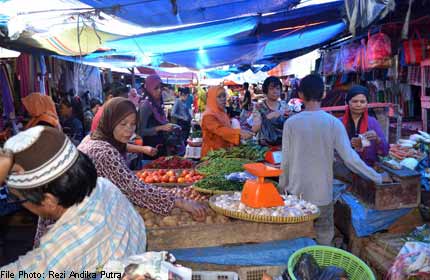
JAKARTA - As soldiers and firefighters from Jakarta pull out of Riau province and environment ministers from the region meet in Kuala Lumpur, life is back to normal for residents in Dumai, the Indonesian city at the epicentre of the region's worst haze to date.
Clear skies came just in time for the start of Ramadan last week. Said trishaw driver Ujang, 45, who has one name: "Thank God, the good weather has improved my takings, and made up for losses during the haze."
But, amid the bustle in the streets and markets, there are worries that any prolonged period of dry weather coming up, combined with the pullout of the heavy military and relief presence, may see open burning resume and take residents back to square one, disrupting their health and livelihood.
The national disaster authorities lifted emergency status last Thursday, 20 days after it was declared, but they will remain on the lookout for any recurrence until the dry season ends in October.
Four helicopters and an airplane for water-bombing and cloud-seeding sorties will remain in Riau in case fires flare up again, the National Disaster Management Agency said.
On Sunday, 226 Marines left Dumai for Jakarta in a gradual pullout of troops and police deployed to put out and investigate forest fires that, coupled with shifting wind patterns this year, sent pollution levels to record highs in Singapore and peninsular Malaysia.
Another 375 Marines sent to Bengkalis, one of the worst-hit regencies, were also pulled back.
Residents forced to relocate because of the haze have also returned home. Dumai resident Wan Umar Dani, 26, said he took his wife and their three-year-old son to neighbouring West Sumatra province for almost a month as he was concerned for their health.

"If it happens again, I will temporarily move again," he said, urging the authorities to keep a closer watch on plantations so the haze does not recur. "They have to act tough on land owners found to have carried out burning."
So far, only one land owner has been named a suspect.
Indonesian National Police spokesman Ronny Sompie told reporters last week that PT Adei Plantation and Industry, a subsidiary of Malaysia's Kuala Lumpur Kepong (KLK), was allegedly responsible for illegally burning to clear land for cultivation.
Another 24 individuals have been identified as having started fires in Riau.
On Monday, KLK took out an ad in the Jakarta Post in response to a report on its involvement. It cited a local forestry official saying the fire was started in an area the company had set aside for conservation, but which the community living near its estates was trying to clear for cultivation.
Adei had in fact taken quick action to help douse the fire, it said. Other pulp and paper companies cited as culpable by non-governmental outfits have issued similar rebuttals.
Meanwhile, the toll is just starting to be tallied up. The Riau Health Agency said at least 10,000 people have developed acute respiratory infections from the haze, more than half of them children under five years of age.
In a report on Indonesia's economy this month, the World Bank estimates the total cost and risk to the overall economic outlook from the haze is "likely to be in the billions of dollars", from resources deployed to put out the fires to degradation of forest and land assets.
It noted that the 1997-1998 haze episode cost South-east Asia some US$9 billion (S$11.4 billion).
"Today, with more sophisticated agriculture and tourism industries in place and higher population density in these areas, the economic losses could be even higher," the bank said.
But, as many in Riau note, the haze has become a persistent problem that is hard to pre-empt. Clearing land is also a source of income for many and, with each dry season, some of the land will inevitably be burnt.

